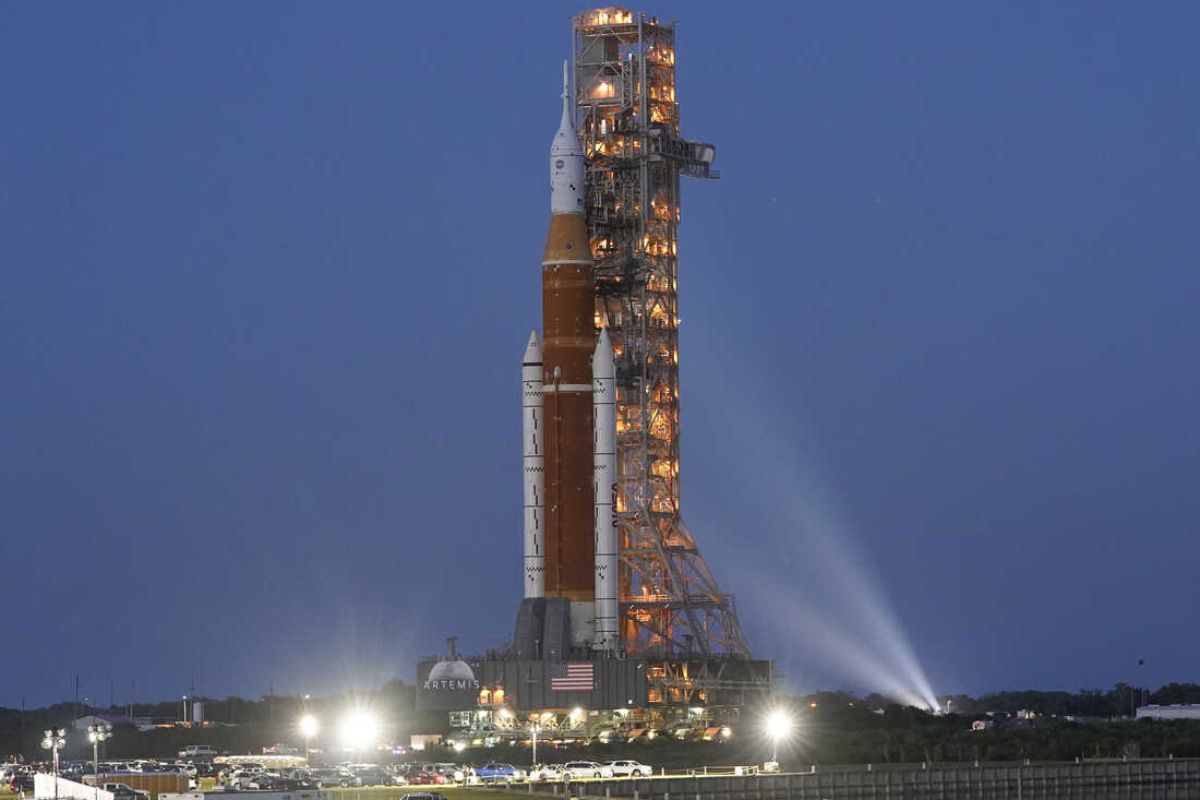NASA has started to figure out how well the Artemis 1 moon rocket did during a strong storm that hit its spaceport in Florida today. Nicole hit Florida’s Space Coast early Thursday morning (Nov. 10) as a Category 1 hurricane, but as it moved inland, it lost strength and became a tropical storm. Nicole’s wind and rain hit the Artemis 1 vehicle at NASA’s Kennedy Space Center, which is sitting on Launch Pad 39B. (KSC).
NASA Assessing Damage To Artemis 1 Moon Rocket
NASA officials say that the Artemis 1 stack, which is made up of a Space Launch System (SLS) rocket and an Orion crew capsule, seems to have been mostly unharmed by the event.

“With the cameras at the launch pad, our team is doing initial visual checks of the rocket, spacecraft and ground system equipment,” Jim Free, associate administrator of the Exploration Systems Development Mission Directorate at NASA headquarters in Washington, said on Twitter on Thursday afternoon.
“Camera inspections show very minor damage like loose caulk and tears in weather coverings,” he said. “The team will soon do more walkaround inspections of the car on site.
During Nicole’s passage, sensors at Pad 39B recorded peak wind gusts of 82 mph (132 kph) at an altitude of 60 feet (18 meters). He said that those wind speeds are “within the rocket’s range.” “We think the vehicle will be ready for those conditions soon.”
NASA officials said in a statement on Tuesday that SLS is built to withstand winds of up to 85 mph (137 kph) at the 60-foot level “with structural margin” (Nov. 8).
Artemis 1 will send Orion on a trip to the moon and back without a crew. NASA is getting ready to send the spacecraft into space as soon as Wednesday (Nov. 16). It’s not clear if Nicole has changed that calculation since Free’s tweet didn’t say anything about the schedule or any possible changes.
Must Read
- NASA, SpaceX Targeting Oct. 5 To Launch Crew-5 Astronauts After Ian Delays
- Black hole Announces Its Presence To Astronomers By Violently Ripping Apart A Star
A time-lapse video shows how NASA’s Artemis 1-moon rocket gets to the launch pad.
Artemis 1 has already been on the ground longer than planned because of the weather. The mission was supposed to take off in late September, but NASA moved SLS and Orion off Pad 39B and back to KSC’s huge Vehicle Assembly Building to avoid Hurricane Ian.
I normally am pretty bullish on NASA's communications team. They work hard and have a difficult job. But since last Thursday the utter lack of access to decisionmakers regarding Artemis I staying at the pad, and effects from Nicole, is glaring. Lots of questions, no answers.
— Eric Berger (@SciGuySpace) November 10, 2022
Artemis 1 returned to the launch pad on November 4. Due to Nicole’s approach, NASA had to delay the launch by two days, from November 14 to November 16. But the mission team decided to keep the rocket on the pad while the storm hit land. The storm turned out to be much stronger than early forecasts said it would be. “The unexpected change in the weather forecast made it too dangerous to go back to the Vehicle Assembly Building in high winds, so the team decided that the launch pad was the safest place for the rocket to wait out the storm,” Free said.
Artemis 1 is, as its name suggests, the first mission in NASA’s Artemis program to study the moon. If Artemis 1 goes well, Artemis 2 could send astronauts on a trip around the moon as soon as 2024.
Then, Artemis 3 will land near the south pole of the moon in 2025 or 2026, if plans stay on track.
What time is Artemis launch?
NASA plans to try to launch the Artemis I mission again on Wednesday, November 16, with the Space Launch System (SLS) rocket carrying the Orion spacecraft. The launch window opens at 1:04 a.m. EST for 120 minutes.
What do you think about our post? Leave a comment below.
Add this page NogMagazin.com to your bookmark for the latest updates.